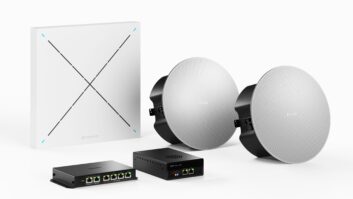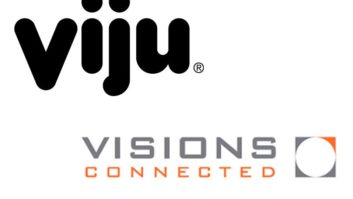
A growing number of unified communications and collaboration companies are bridging across the UCC marketplace through partnerships. But is it down to a shift in the hardware-software balance of power, or a new approach to the pursuit of excellence?
Most up-to-date figures show that an extremely low percentage of meeting rooms are currently equipped with video functionality, just 4% according to an IMCCA (Interactive Multimedia and Collaborative Communications Alliance) panel at InfoComm 2017.
Due not only to the number of companies in this space, but also the wide-ranging functionality of products on offer, UCC is currently one of the most rapidly developing areas of AV, with the majority of the potential market still untapped.
As a response to growing levels of competition, manufacturers are increasingly looking at partnerships. This year both Crestron and Polycom have produced hardware that is compatible with Zoom, a web conferencing service and relatively new to the AV space. Oblong has introduced integrations with the Microsoft ecosystem including calendar and video integration with Microsoft Exchange and Skype for Business. This is designed to make it simpler to schedule and start Mezzanine meetings using familiar daily enterprise tools. Also, Lifesize has added integration with Slack and HipChat to existing agreements with Skype for Business and IBM Sametime.
Changing landscape
But what is behind this drive to partner? “The collaboration landscape is changing, and a one-size-fits-all approach is no longer adequate,” observes Sudeep Trivedi, head of partnerships for Logitech Video Collaboration. “Previously a number of videoconferencing vendors have operated in a bit of a walled garden, but the customer demand for flexibility and interoperability has forced them to bring down their walls, with the number of recent partnership announcements reflecting this.”
Software needs high-performance devices/hardware to deliver its magic
Mary Ann de Lares Norris, Oblong
“The drive to partner comes from a drive for excellence,” says Mary Ann de Lares Norris, VP EMEA of Oblong Industries, before adding: “To deliver an engaging workplace, companies need to invest in disruptive, next-generation systems that are quite often a combination of best-in-class.”
Tim Stone, VP of EMEA marketing at Polycom, states: “Strong partnerships and open standards have always been the foundation of the value we bring to our customers. Our partnerships with Zoom and Microsoft extend the benefits of our solutions to a greater customer base. While our mutual customers with Zoom can now enjoy a great, flexible video experience, our solutions are also helping the Skype for Business users to seamlessly connect to any other standards-based video system without having to leave the familiar Microsoft environment. This is how we ensure we deliver the best user experience and promote ease of use of our technology.”
For Lifesize, it’s about fitting in with the customers’ workflow. “At Lifesize, we are focused on delivering an unmatched communication and collaboration experience that is very easy to use,” comments Michael Helmbrecht, chief product and operations officer, Lifesize. “Enabling customers to have a workflow that lets them integrate Lifesize with their other communication and collaboration tools makes it easier for users and more beneficial.”
Shift of emphasis
What has also become apparent in recent years is a shifting of emphasis from hardware solutions to software, with the emergence of services like Zoom and Skype for Business. Where does this put traditional AV conferencing vendors? And are they still able to influence the direction of the technology?
“It’s an interesting time within our industry,” says Trivedi. “The steep decline in the price-to-performance ratio of computing power, along with ever more powerful cloud services, is causing a general decline in traditional conferencing systems that are based on proprietary codecs. Certainly the move to the cloud, whether a company relies on Skype for Business, Zoom or any number of cloud-based conferencing and collaboration platform providers, will impact how legacy video vendors are addressing customer needs. I also believe the market will see great disruption from new entrants to the market, such as Amazon Chime. It’ll be interesting to see how the incumbents respond.”
“The pace of innovation is staggering and software is clearly driving this pace,” adds de Lares Norris. “However, software needs high-performance devices/hardware to deliver its magic, so hardware per se is not going away anytime soon. Hardware vendors need to understand how to wrap cutting-edge software around their devices to deliver continuing improvements and dynamism to the user experience.”
www.lifesize.com
www.logitech.com
www.oblong.com
www.polycom.com







